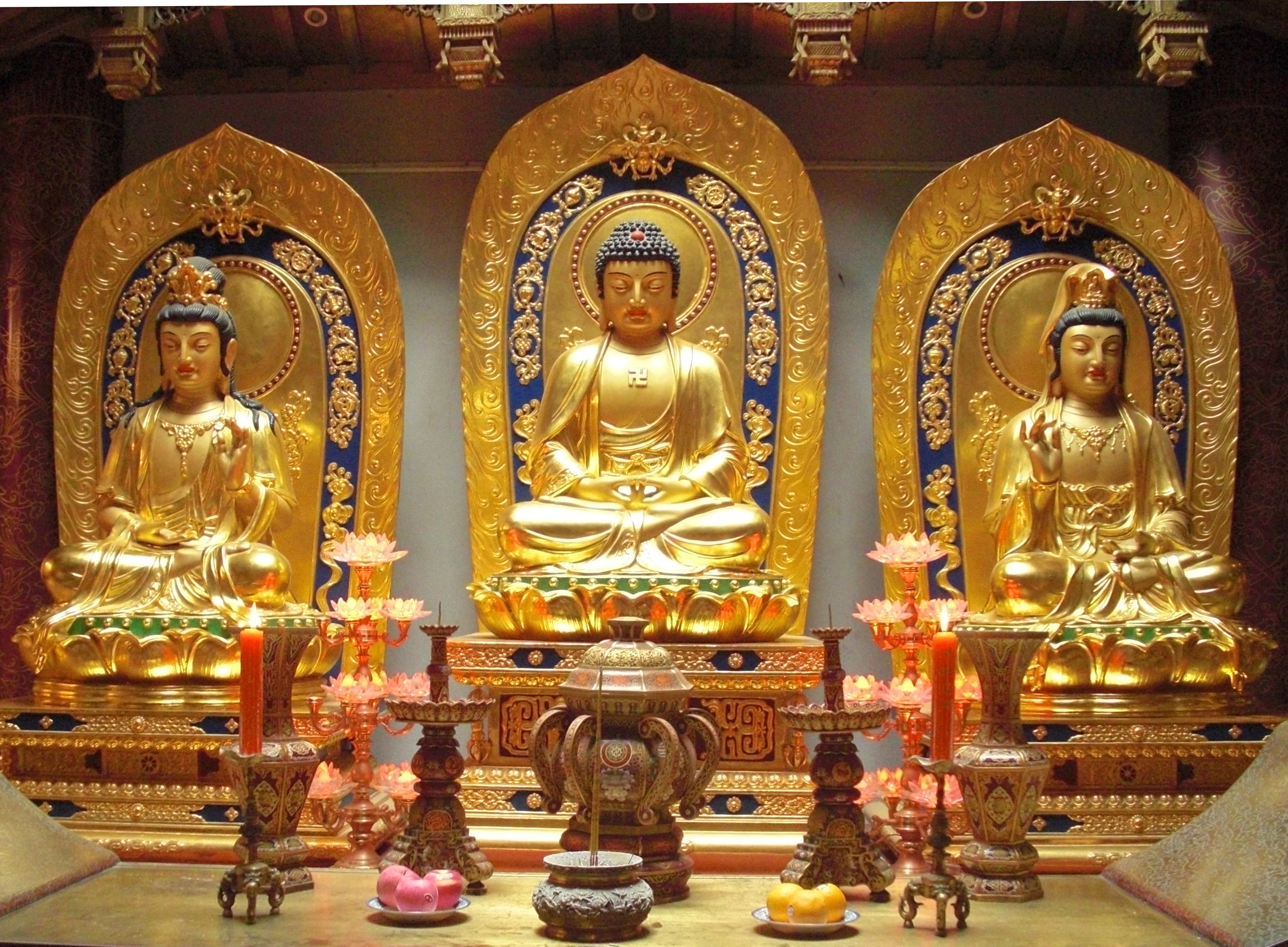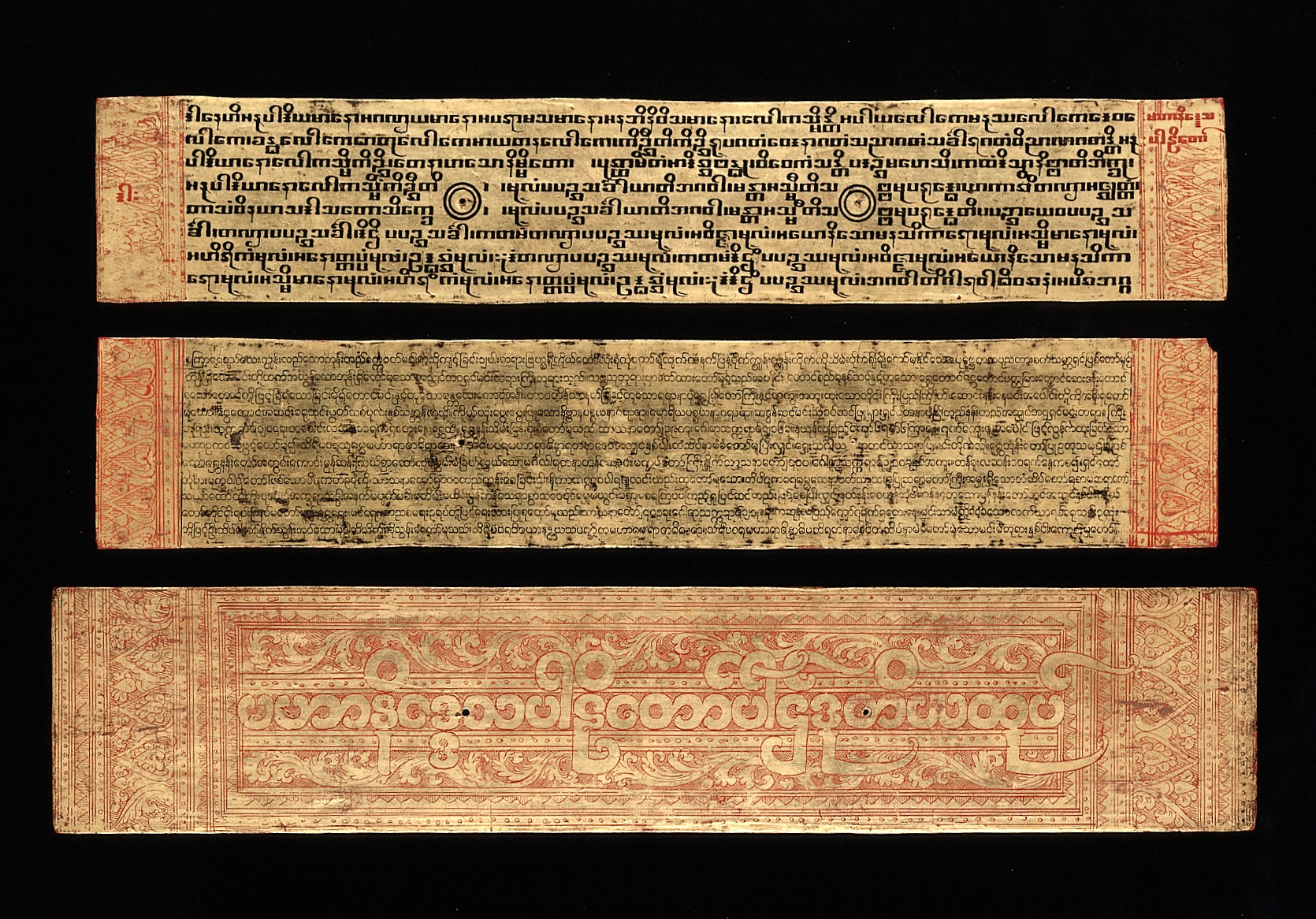|
Nenbutsu
250px, Chinese Nianfo carving The Nianfo ( zh, t= 念佛, p=niànfó, alternatively in Japanese ; ; or ) is a Buddhist practice central to East Asian Buddhism. The Chinese term ''nianfo'' is a translation of Sanskrit '' '' ("recollection of the Buddha"), a classic Buddhist mindfulness (smṛti) practice. Nianfo focused on the Buddha Amitābha is also the most important practice in Pure Land Buddhism. In the context of East Asian Pure Land practice, nianfo typically refers to the oral repetition of the name of Amitābha through the phrase "Homage to Amitabha Buddha" ( Ch: 南無阿彌陀佛, Mandarin: Nāmó Āmítuófó, Jp: Namu Amida Butsu; from the Sanskrit: Namo'mitābhāya Buddhāya). It can also refer to that phrase itself, in which case it may also be called ''the'' nianfo, or "The Name" (Japanese: ''myōgō'' 名号). In most extant Pure Land traditions, faithfully reciting the name of Amitābha is mainly seen as a way to obtain birth in Amitābha's pure land of Sukhāv ... [...More Info...] [...Related Items...] OR: [Wikipedia] [Google] [Baidu] |
Pure Land Buddhism
Pure Land Buddhism or the Pure Land School ( zh, c=淨土宗, p=Jìngtǔzōng) is a broad branch of Mahayana, Mahayana Buddhism focused on achieving rebirth in a Pure land, Pure Land. It is one of the most widely practiced traditions of East Asian Buddhism, Buddhism in East Asia. It is also known as the "Lotus School" (Chinese language, Chinese: 蓮宗; pinyin: ''Liánzōng'') in China or the "Nianfo, Nembutsu school" in Japan. East Asian Pure Land mainly relies on three main Mahayana sutras, Mahayana scriptures: the ''Longer Sukhāvatīvyūha Sūtra, Sutra of Amitayus'', the ''Amitāyus Contemplation Sūtra, Contemplation Sutra'' and the ''Shorter Sukhāvatīvyūha Sūtra, Amitabha Sutra''. The Pure Land tradition is primarily focused on achieving rebirth in a Buddhahood, Buddha's "pure land", a superior place to spiritually train for full Buddhahood, where one can meet a Buddha face to face and study under them without any of the distractions or fears of our world.Williams, Pau ... [...More Info...] [...Related Items...] OR: [Wikipedia] [Google] [Baidu] |
Saṃsāra
''Saṃsāra'' (Devanagari: संसार) is a Sanskrit word that means "wandering" as well as "world," wherein the term connotes "cyclic change" or, less formally, "running around in circles." ''Saṃsāra'' is referred to with terms or phrases such as transmigration/reincarnation, karmic cycle, or Punarjanman, and "cycle of aimless drifting, wandering or mundane existence". When related to the theory of karma, it is the cycle of death and rebirth. The "cyclicity of all life, matter, and existence" is a fundamental belief of most Indian religions. The concept of ''saṃsāra'' has roots in the post-Vedic literature; the theory is not discussed in the Vedas themselves. It appears in developed form, but without mechanistic details, in the early Upanishads. The full exposition of the ''saṃsāra'' doctrine is found in early Buddhism and Jainism, as well as in various schools of Hindu philosophy. The ''saṃsāra'' doctrine is tied to the karma theory of Hinduism, and th ... [...More Info...] [...Related Items...] OR: [Wikipedia] [Google] [Baidu] |
Ekottara Agama
The ''Ekottara Āgama'' (Sanskrit; ) is an early Indian Buddhist text, of which currently only a Chinese translation is extant ( Taishō Tripiṭaka 125). The title ''Ekottara Āgama'' literally means "Numbered Discourses," referring to its organizational principle. It is one of the four Āgamas of the Sūtra Piṭaka located in the Chinese Buddhist Canon. Origins and history According to Tse Fu Kuan, "in 385 AD Zhu Fonian (竺佛念) completed a Chinese translation of the Ekottarika-āgama recited by Dharmanandin (曇摩難提), a monk from Tukhāra. This first translation, in forty-one fascicles, was later revised and expanded by Zhu Fonian into the Ekottarika-āgama in fifty-one fascicles that has since come down to us. Zhu Fonian probably added new material to his first translation and even replaced some passages of his first translation with new material." Scholars such as Yin Shun, Zhihua Yao and Tse Fu Kuan consider the Ekottara Āgama to belong to the Mahāsāṃ ... [...More Info...] [...Related Items...] OR: [Wikipedia] [Google] [Baidu] |
Āgama Section
The Āgama Section ( zh, 阿含, p=Āhán Bù; ) is a division of the Taishō Tripiṭaka that contains sūtras related to the Āgamas, roughly corresponding to the texts of the '' Sutta Piṭaka'' of the Pāli Canon The Pāḷi Canon is the standard collection of scriptures in the Theravada Buddhism, Buddhist tradition, as preserved in the Pāli language. It is the most complete extant Early Buddhist texts, early Buddhist canon. It derives mainly from t .... It corresponds to the first two volumes of the Taishō Tripiṭaka and corresponds to text numbers 1–151. Notable collections within this section include the '' Dīrghāgama'' (長阿含經; T1), '' Madhyamāgama'' (中阿含經; T26), '' Saṃyuktāgama'' (雜阿含經; T99), and the '' Ekottarāgama'' (增壹阿含經; T125), while the section also includes individual sūtras that were translated separately from these collections, but which contain parallels therein, such as the '' Dharmacakrapravartana Sūtra' ... [...More Info...] [...Related Items...] OR: [Wikipedia] [Google] [Baidu] |
Nirvana (Buddhism)
Nirvana or nibbana (Sanskrit: निर्वाण; International Alphabet of Sanskrit Transliteration, IAST: '; Pali: ') is the extinguishing of the passions, the "blowing out" or "quenching" of the activity of the grasping mind and its related unease. Nirvana is the goal of many Buddhism, Buddhist paths, and leads to the soteriological release from dukkha ('suffering') and rebirths in ''Saṃsāra (Buddhism), saṃsāra''. Nirvana is part of the Third Truth on "cessation of ''dukkha''" in the Four Noble Truths, and the "''summum bonum'' of Buddhism and goal of the Noble Eightfold Path, Eightfold Path." In all forms of Buddhism, Nirvana is regarded as the highest or supreme religious goal. It is often described as the unconditioned or uncompounded (Skt.: asaṃskṛta, Pali: asankhata), meaning it is beyond all forms of conditionality — not subject to change, decay, or the limitations of time and space. Nirvana is typically seen as being outside the realm of dependent ari ... [...More Info...] [...Related Items...] OR: [Wikipedia] [Google] [Baidu] |
Samādhi
Statue of a meditating Rishikesh.html" ;"title="Shiva, Rishikesh">Shiva, Rishikesh ''Samādhi'' (Pali and ), in Hinduism, Buddhism, Jainism, Sikhism, is a state of meditative consciousness. In many Indian religious traditions, the cultivation of Samādhi through various meditation methods is essential for the attainment of spiritual liberation (known variously as nirvana, moksha). In Buddhism, it is the last of the eight elements of the Noble Eightfold Path. In the Ashtanga Yoga tradition, it is the eighth and final limb identified in the '' Yoga Sutras'' of Patanjali. In Jain meditation, samadhi is considered one of the last stages of the practice just prior to liberation. In the oldest Buddhist sutras, on which several contemporary western Theravada teachers rely, it refers to the development of an investigative and luminous mind that is equanimous and mindful. In the yogic traditions and the Buddhist commentarial tradition, on which the Burmese Vipassana movemen ... [...More Info...] [...Related Items...] OR: [Wikipedia] [Google] [Baidu] |
Aṅguttara Nikāya
The ''Aṅguttara Nikāya'' ('; , also translated "Gradual Collection" or "Numerical Discourses") is a Buddhist scriptures collection, the fourth of the five Nikāyas, or collections, in the Sutta Pitaka, which is one of the "three baskets" that comprise the Pali Tipitaka of Theravada Buddhism. This nikaya consists of several thousand discourses ascribed to The Buddha and his chief disciples arranged in eleven "books", according to the number of Dhamma items referenced in them. Overview Translator Bhikkhu Bodhi wrote: "In Anguttara Nikaya, persons are as a rule not reduced to mere collections of aggregates, elements, and sense-bases, but are treated as real centers of living experience engaged in a heartfelt quest for happiness and freedom from suffering." (from Intro to Samyutta Nikaya) Parallel The Anguttara Nikaya corresponds to the ''Ekottara Āgama'' ("Increased by One Discourses") found in the Sutra Pitikas of various Sanskritic early Buddhists schools, fragmen ... [...More Info...] [...Related Items...] OR: [Wikipedia] [Google] [Baidu] |
Suttas
Buddhist texts are religious texts that belong to, or are associated with, Buddhism and Schools of Buddhism, its traditions. There is no single textual collection for all of Buddhism. Instead, there are three main Buddhist Canons: the Pāli Canon of the Theravada, Theravāda tradition, the Chinese Buddhist canon, Chinese Buddhist Canon used in East Asian Buddhism, East Asian Buddhist tradition, and the Tibetan Buddhist canon, Tibetan Buddhist Canon used in Tibetan Buddhism, Indo-Tibetan Buddhism. The earliest Buddhist texts were not committed to writing until some centuries after the death of Gautama Buddha. The oldest surviving Buddhist manuscripts are the Gandhāran Buddhist texts, found in Pakistan and written in Gāndhārī language, Gāndhārī, they date from the first century BCE to the third century CE. The Early Buddhist texts, first Buddhist texts were initially passed on orally by Buddhist monasticism, Buddhist monastics, but were later written down and composed ... [...More Info...] [...Related Items...] OR: [Wikipedia] [Google] [Baidu] |
Pali Canon
The Pāḷi Canon is the standard collection of scriptures in the Theravada Buddhism, Buddhist tradition, as preserved in the Pāli language. It is the most complete extant Early Buddhist texts, early Buddhist canon. It derives mainly from the Tamrashatiya school. According to Buddhist tradition, during the First Buddhist Council, three months after the parinibbana of Gautama Buddha in Rajgir, Ananda recited the Sutta Piṭaka, Sutta Pitaka, and Upali recited the Vinaya Piṭaka, Vinaya Pitaka. The Arhats present accepted the recitations, and henceforth, the teachings were preserved orally by the Sangha. The Tipitaka that was transmitted to Sri Lanka during the reign of King Asoka was initially preserved orally and later written down on palm leaves during the Fourth Buddhist Council in 29 BC, approximately 454 years after the death of Gautama Buddha. The claim that the texts were "spoken by the Buddha" is meant in this non-literal sense. The existence of the Bhāṇaka tradi ... [...More Info...] [...Related Items...] OR: [Wikipedia] [Google] [Baidu] |
Anussati
(Pāli; ; ; ) means "recollection," "contemplation," "remembrance," "meditation", and " mindfulness". It refers to specific Buddhist meditational or devotional practices, such as recollecting the sublime qualities of the Buddha, which lead to mental tranquillity and abiding joy. In various contexts, the Pali literature and Sanskrit Mahayana sutras emphasise and identify different enumerations of recollections. may also refer to meditative attainments, such as the ability to recollect Rebirth (Buddhism), past lives (), also called causal memory. Grouping Three recollections The three recollections: :* Recollection of the Buddha Siddhartha Gautama, most commonly referred to as the Buddha (),* * * was a śramaṇa, wandering ascetic and religious teacher who lived in South Asia during the 6th or 5th century BCE and founded Buddhism. According to Buddhist lege ... (; ; ) :* Recollection of the Dhamma (Pi. ; Skt. ; Tib. ) :* Recollection of the Sangha (B ... [...More Info...] [...Related Items...] OR: [Wikipedia] [Google] [Baidu] |





